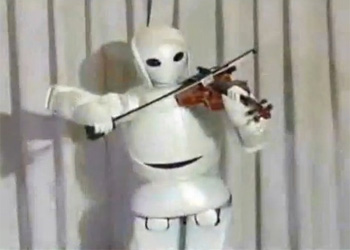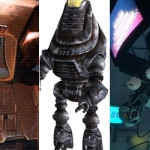
In honor of Robot Month on Fandomania, let’s take a look at some robots that play music. The Japanese in particular are on the cutting edge of making increasingly humanistic machines, including ones that can play instruments — even instruments that require the coordination of many different skills, like the trumpet or violin, as these robots made by Toyota demonstrate:
Once you can build a machine that is mechanically able to replicate all the necessary movements, and after you program the machine’s computer to deliver instructions for movement in the correct sequence, you can even program the robots to play together:
But just because they are producing sounds on a musical instrument in harmonic, rhythmic, and melodic patterns considered by the human ear to be “musical,” does that mean they are really musicians? I think most people would say no, they are simply executing code like any other computer, programmed into it by a human. They are still dependent on the creative capacity of a person in order to make music. The robot cannot improvise or compose a song, or respond to stimuli outside of its programming like human musicians do when they play together, responding to the often subtle physical and aural cues given by a conductor or other members of the group. Additionally, while the robots you saw above are technically proficient, they still lack the spontaneity and emotion that human players bring to their performances.
Interestingly enough, one of the catalysts for this article is a video featuring a robot that can respond to musical cues improvise along with human musicians. If you are a fan of college football or basketball and follow teams in the Atlantic Coast Conference, you may have seen this commercial for the Georgia Institute of Technology (Georgia Tech) in Atlanta:
At first glance, the robot marimba player looks like yet another nifty toy showing off some engineer’s superior programming skills, but in fact it is something very different. Meet Shimon, developed by a group led by Professor Gil Weinberg of the Georgia Tech Center for Music and Technology. Shimon and his drummer predecessor Haile can improvise musical patterns on their instruments in response to patterns played by human musicians. Following are two video clips — the first is a brief demonstration of Haile’s talents, followed by the highlights of Shimon’s first public performance of a jazz piece composed for it and a human pianist that is designed to show off Shimon’s unique talents. It also provides a bit of explanation about the different musical elements that Shimon is able to detect, analyze, and respond to.
And here are Haile and Shimon working together with two human musicians in a jam session of improvised music with a Middle Eastern flair:
These two robots, particularly Shimon, are really neat, and I highly recommend looking for more of them on YouTube. So does this mean that human musicians may really one day be out of a job? Well, no, I don’t think so. Although Shimon can respond to what it hears and produce sounds that fit with the other accompanying instruments, it still can’t create something on its own without other input, like a human can, and it still lacks the emotional qualities that humans bring to a piece, whether it is rock, jazz, country, or classical. One important fact that Shimon’s creators emphasize, however, is that Shimon was designed not to replace human musicians, but to provide people with a new kind of musical stimulus that will hopefully prompt them to greater creativity and innovation in their music-making as human and robot interact with each other.
So what do you think? Will orchestras be a thing of the past as robots take over the musicians’ jobs on stage, or do you believe Shimon’s creators when they say that robots will drive human musicians to greater heights? Feel free to discuss in the comments, and stay tuned for another Geek’s Guide later this month as we turn the tables and look at the ways human composers make music using electronic instruments. See you next time! Class dismissed.






